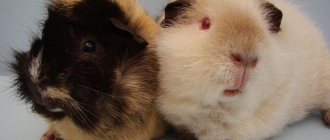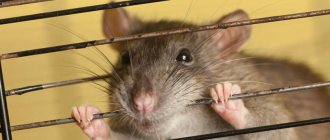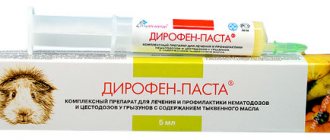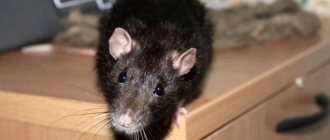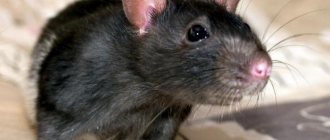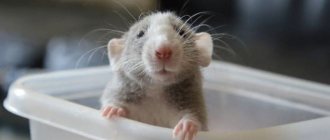Unfortunately, the lifespan of a decorative rat is only 2-3 years. During this time, owners become strongly attached to their pets and learn all their habits and habits. Therefore, parting is always difficult and painful, both for adults and children.
Let's find out what signs indicate the approaching death of a pet so that we can prepare in advance and decide what to do with the body.
A pet rat is dying: signs and causes
Decorative rats kept as pets become loyal friends and family members for their owners. These smart, cheerful and nimble rodents conquer the hearts of people and settle in them for a long time. But unfortunately, the real life of the little tailed comrades is short - its average duration is 2-3 years. Rarely does a rat manage to reach a more advanced age. A two-year-old animal is already considered elderly. How to understand that a rat is dying, how to alleviate its suffering and what to do when everything happens is described in the article.
Causes of death of an ornamental rodent
Domestic rats do not have good health and strong immunity. Therefore, during their already short life, they fall ill several times, and the diseases that affect them can be of a different nature.
Pathologies in animals occur and develop rapidly - this is due to the accelerated metabolism of rodents. Because of this transient nature of the disease, delay in treatment often results in the rat dying.
The death of domestic rodents may be due to the following reasons:
- respiratory diseases, both non-contagious and infectious in origin;
- injuries received from falls from height, etc.;
- poor or inappropriate living conditions;
- infections;
- stroke;
- oncology;
- old age.
90% of elderly females have oncology, and the majority of old rodents, regardless of their gender, develop pathologies that affect the respiratory organs and musculoskeletal system. As a result, the animals become weak. They lose the ability to move and feed independently.
Not all animals suffer such a tragic fate. Some rats (mostly males) manage to remain vigorous until the very last day and die of old age in their sleep without pain or suffering.
If a pet is suffering from pain, in order to alleviate the suffering of the unfortunate animal, it is recommended to euthanize it.
Genetics
The lifespan of a house mouse is influenced not only by lifestyle, but also by genetic predisposition.
The fact is that in pet stores, rats live in mixed-sex packs , which does not happen in the wild. Animals living in crowds mate uncontrollably, after which they live in cramped conditions unsuitable for normal existence. It is very difficult to trace the genetics of such an animal, so it is impossible to say how long such a rat will live and what life awaits it.
A completely different situation arises when animals are bred by a breeder. Matings in such cases are planned, and partners are selected depending on temperament. Rat pups from peaceful, sociable parents are prepared for sale as pets. Such babies are brought up in a favorable environment, which prevents the pet from displaying aggression in the future.
Females in nurseries give birth to cubs no more than twice a year . Frequent pregnancies exhaust the animal, as a result of which it produces weak, non-viable litters.
In order for a pet to be healthy, please its owners and live a long life, it must be purchased only in special institutions.
You will learn how to make the life of a pet rat comfortable in this video.
How to recognize the aging of an animal and its imminent death
With good home maintenance and a caring attitude from the owner, the animal can live longer than the average 2-3 years. You can understand that a pet’s life is coming to an end when it reaches old age. In turn, it is possible to determine that an animal has aged by a number of characteristic signs. These include:
- rapid weight loss (the outlines of the ribs and spine begin to be visible through the fur);
- decreased wool density;
- loss of appetite or refusal to eat (if he eats, then only soft food);
- heavy, frequent and difficult breathing;
- refusal to wash, water procedures, care activities;
- dullness of the eyes;
- disturbances or complete loss of coordination;
- sneeze;
- fragility of hairs;
- difficulty moving (walks hard, cannot climb onto the top tier of the cage, etc.);
- blindness;
- convulsions;
- ruffled coat;
- paralysis of the limbs (usually the hind limbs);
- frequent and long rest (lying in a hammock, etc.);
- desire for privacy and comfort;
- indifference to games and toys;
- inactivity;
- apathy in behavior and outlook.
Types of stroke
Stroke in pet rats is divided into two types - hemorrhagic and ischemic.
Hemorrhagic stroke is intracerebral hemorrhage. Ischemic stroke is a disorder of cerebral blood circulation that damages brain tissue.
For convenience, consider the table:
| Hemorrhagic | Ischemic | |
| Onset of the disease | Sudden | Gradual |
| External signs | Increased sweating, cramps, hyperemia | Not expressed |
| Motor excitement | Expressed | Not expressed/Rarely |
| Convulsions | Yes | Rarely |
| Breath | Snore | Often no change |
| Impaired consciousness | Swift | Slow |
Based on the above, we can conclude that with a hemorrhagic stroke in an animal due to a rupture of an artery or a traumatic brain injury, the stroke occurs spontaneously, and this type of disease is considered more dangerous, more often leading to death.
Ischemic stroke, which occurs as a result of narrowing or blockage of individual vessels, occurs differently; if the development of this type was rapid and with loss of consciousness, then, most likely, an embolic type occurred.
How to Care for an Elderly Pet Rat
For every owner, the thought of the impending separation from a beloved and loving pet is painful. The death of rats, like other ornamental animals, cannot be predicted. It is all the more difficult for the owner of a pet to come to terms with the inevitable loss of his little faithful friend.
An elderly animal vitally needs the attention of its owner. Caring for the tailed “old man” should be proactive. The owner of an old animal must:
- remove all tiers from the cage - the “old man’s” home should be one-story;
- lay soft cloth, toilet paper or napkins on the bottom of the cage as a bedding covering the half-grate; instead of coarse filler;
- place the hammock, food and drink bowls and other rat household items as low as possible;
- help your pet climb into a hammock or house if he is unable to do so;
- wipe the rodent’s mouth, nose and eyes with a damp swab after each meal;
- clean your pet’s ears with a cotton swab soaked in saline solution once a day;
- wash the intimate parts of the animal daily with a solution of chlorhexedine;
- communicate with the animal as often as possible (pet it, caress it, pick it up, sit it on your lap, etc.).
Old age negatively affects the condition of the animal’s teeth, so the “old man’s” diet should consist of soft and semi-solid food:
- various cereals;
- yoghurts;
- cereal;
- dried bread;
- baby food, etc.
If the animal cannot handle the nipple drinker, you need to replace it with a regular bowl of water. In addition, it is worth including more succulent food - berries and fruits - in your rat's diet. Be sure to feed your pet with special vitamins for rats.
What to do after the death of a rat
When a pet passes away, it is difficult for its owner to gather his thoughts and figure out what to do. It is impossible to bury the body of an unfortunate animal in public gardens and parks - the result of such a burial will be poisoning of the soil and water, as well as the spread of infections.
When a rat dies, it must be buried in a special pet cemetery. Such cemeteries can be found in many cities. If one could not be found, the animal can be buried in the forest far from the city limits. To prevent the pet's body from being dug up by predators, the depth of the burial pit should be 1.5-2 m.
An alternative option is cremation. It is carried out in veterinary clinics.
Regardless of the age of the animal, it should be surrounded by love and care. Not only an elderly animal, but also a young one deserves the attentive and caring attitude of the owner. Otherwise, the pet may simply not live to old age.
The rat is dying :(((
The rat is dying :((( ¶
From: Poc - May 18, 2005 5:10 am
I recently noticed that my rat has lost his appetite, and today she has some strange cramps: contractions on the sides of her stomach, and her stomach contracts very strongly and some kind of wheezing or something. And in the evening she began to feel unsteady and I noticed that her teeth were in poor condition. She can’t find a place for herself, as if she’s preparing a nest. She feels very bad, and it pains me terribly to watch her suffer. roar roar roar This is a blue rat, she is 2 years old. What can be done? Help, please I pray_n I pray_n I pray_n
How do rats die of old age?
What to do if a decorative rat dies: signs and causes of imminent death
The decorative rat is one of the most popular types of pets. These animals are very smart and quickly become attached to humans, but, unfortunately, they live only 2-3 years. An aging rat changes its habits several months before death, and the approach of this event can be noticed by characteristic signs. Read more about how to recognize that an animal will soon die of old age, as well as the basic rules for caring for an animal before death and the specifics of burying a pet in the article.
How to tell if a rat is dying of old age
When keeping a decorative rat at home, you need to carefully monitor the health of the pet, as well as provide it with proper care and careful handling. This will protect the animal from many dangerous diseases, and if they appear, begin treatment in a timely manner to save the pet.
But if a rat dies of old age, then, unfortunately, it will no longer be possible to cure it. The aging of an animal can be determined by its characteristic external signs, as well as by the behavior of the rodent before death.
External signs
Even with good care and a balanced diet, a rat's appearance changes with age. The first signs of aging in a rodent appear around the second year of its life.
At the same time, the following changes are observed in the appearance of the animal:
- the pet is losing weight, despite a high-quality and balanced diet;
- the spine and ribs of the rodent can be easily felt with your fingers;
- the thickness of the coat decreases, and bare areas without hair may even appear on the skin;
- the pet looks disheveled, and the hairs become brittle and dull;
- vision deteriorates, and the animal’s eyes lose their characteristic shine;
- the rodent is breathing heavily or sneezing frequently;
- There is abundant clear discharge (porphyrin) in the corners of the pet's eyes.
Behavior of decorative rats before death
In addition to external signs, the aging of a decorative rat is also evidenced by some changes in its behavior. At first they are not too noticeable, but the older the pet gets, the calmer he begins to behave.
The main features of the behavior of rodents before imminent death from old age:
- lack of coordination of movements - the rat staggers while walking and cannot immediately grab the food offered to it;
- decrease in general activity - the pet begins to spend more time in its nest or house, loses interest in toys and active movements;
- inability to climb up - as many rats get older, the performance of their hind limbs is impaired, so it is difficult for animals to climb heights or climb an inclined surface;
- lack of regular “washing” - the rodent stops cleaning its face and fur on its body, preferring not to waste energy on this procedure;
- decreased appetite - as a result of a sedentary lifestyle, the animal no longer needs a lot of food;
- eating only soft foods - they are more easily absorbed by a weakened body, without requiring much chewing effort from the animal.
The impact of nutrition on health
The rat's diet must be balanced and extremely healthy. The food you eat yourself may not be suitable for your pet. This is especially true for fried, spicy, fatty, and sweet foods. Do not give domestic rodents anything that they would never obtain in the wild.
Any deviation from the normal diet entails liver problems, obesity of internal organs, kidney dysfunction and rapid weight gain. Accordingly, the already short lifespan of domestic rats is halved.
Did you know? Rat teeth are so strong that they easily crush concrete and certain metal alloys. Their teeth grow without slowing down throughout their lives, so rats are forced to constantly grind them down on something.
What can you feed rats:
- Nuts and grains. Nuts contain the protein rodents need, although you should limit yourself to walnuts and give them one a day. Cereals are a reliable source of carbohydrates, and sprouted grains contain important vitamin E, which strengthens the immunity of warm-blooded creatures. Any grains other than wheat are suitable for rats - buckwheat, rice, rye, oats.
- Vegetables, fruits, berries, herbs. They form the basis of the diet of rodents - you can feed them with the products that are grown in your region. No tropical fruits or imported arugula. It is better to give vegetables boiled, and large seeds will have to be removed from fruits and berries first. In winter, diversify your pet's diet with fresh frozen berries, having previously defrosted them. In the summer, you can use dandelion leaves and stems as greenery; your pet will eat them with pleasure.
- Dried fruits. The rat will eat everything - prunes, dried apricots, dried pears and apples. Dried berries will also benefit her.
- Meat and fish.
There is an opinion that rats should not be given meat products. This is not true - rodents eat meat, but rarely, so you can feed them boiled (in no case fried or raw) fish and meat on weekends. Feeding eggs should be the same - hard-boiled, in small portions once a week. You cannot feed a rat milk, but fermented milk cheese will improve its intestinal microflora and provide it with the necessary calcium. - Mineral supplements. This includes chalk, calcined tablets, and ordinary charcoal. Make sure that your pet’s diet is balanced in vitamins - buy him vitamin complexes for rodents.
What not to give to rats:
Raw foods. This includes all vegetables except carrots, and meat, raw and fried.
Pay special attention to fatty meats such as pork. It cannot be fed even boiled.
Milk and carbonated drinks
Milk can cause volvulus in your pet, and carbonated drinks are not even beneficial for humans.
Vegetables and fruits are green. Exclude apples, cucumbers, sweet peppers, zucchini, and unripe bananas from your pet’s diet.
Sweet, spicy, salty. What is acceptable for humans is prohibited for rodents. From too active food, they develop problems with the gastrointestinal tract and exhibit allergic reactions.
Important! The immunity of ornamental rodents, originally bred for laboratory tests, is much weaker than that of their gray wild relatives, who do not mind drafts, sunlight and stale scraps. You need to be prepared for the fact that your pet will reach the peak of its development by one and a half years, and will die of old age at two and a half years, if it does not become a victim of some infectious disease before this time.
How to care for an animal that is about to die
An aging rat needs special treatment, so it needs to be properly cared for.
In this case, it is impossible to delay the date of your pet’s death, but in order to make your pet’s life more comfortable, you need to follow these recommendations:
- install all objects in the cage at the level of the first floor - it is better to remove stairs and vertical labyrinths so that the rodent is not injured as a result of falling from them and has convenient access to water, food and a resting place;
- if it is difficult for an animal to move independently, then periodically move it to the feeder, drinking bowl and nest ;
- wipe the pet’s mouth, nose and eyes with a damp cotton pad after each meal to remove secretions and clean the rat’s face from food residues;
- treat the rodent's genital openings daily soaked in a chlorhexidine solution - this will help prevent the development of infectious diseases and inflammations;
- regularly clean the rat's ears with a cotton swab dipped in saline solution;
- adjust the animal's diet , making it up of soft foods - porridge, cereal, baby food, yoghurt, slightly dried bread;
- give the animal fresh fruits and berries to further enrich its body with fluids;
- introduce special vitamins into your pet’s diet - they support the performance of the aging body;
- cover the bottom of the cage with soft materials - cloth, napkins or toilet paper;
- handle the animal carefully , pet it often and place it on your lap.
Danger to humans
If “Rat Death” is used correctly, it does not cause harm to humans. The drug does not release active components into the air, so the risk of “inhaling” poisons is completely eliminated. And even if you accidentally touch the poison with your hands, you will not face any negative consequences after thoroughly washing your hands with soap.
Symptoms of intoxication
Poisoning can occur only in one case - if the poison gets into the stomach. Moreover, it all depends on the dose. If a small amount of poison enters the digestive system, the liver will independently deactivate the toxin. But in the case of deliberate consumption of poison (for example, by small children), there is a threat to life. If signs of intoxication appear, be sure to seek help from a doctor. Only specialists can prevent the development of internal bleeding. The following symptoms indicate poisoning:
The antidote to the anticoagulant is the drug “Vikasol”. It is not able to neutralize Rat Death, but completely compensates for the effect of the poison. In case of minor intoxication, tablets will help; in case of severe poisoning, Vikasol is administered intravenously in a hospital setting for 15-30 days.
What to do if there was contact with poison
Even the most careful handling of the drug cannot always protect against accidental contact. If you come into contact with poison, do not panic. Take all measures to minimize the risk of intoxication. If the poison is ingested:
Do not forget that poison is dangerous not only for people, but also for animals. If your pet has ingested a dangerous drug, take it to the vet immediately. The animal will need intestinal lavage, detoxification therapy, and vitamin K injections.
Reviews of “Death of the Rat” are mostly positive. Those who have tested the poison emphasize its ease of use and high effectiveness in the fight against rodents. Many people share a way to protect children and pets from eating poison. To do this, you need to take a closed box and cut small holes in it, allowing only the rat to get inside. Briquettes are placed at the bottom. The rat will easily get in and out, and children and pets will be reliably protected from the temptation to “test their teeth.”
“Rat Death” - how to get rid of rats, review
What to do after the death of a pet
Rats are affectionate and intelligent animals that love their owners very much, so many people find it difficult to come to terms with the loss of a pet . But after the death of an animal, it is necessary to take care of its proper burial, and also focus on how to survive the death of a pet.
How to bury
The body of a dead rat can become a source of dangerous infectious diseases, so you need to know how to properly bury the animal. Some people bury dead pets in flower beds near their home or in parks, but as a result, decomposition products can enter the soil and groundwater, poisoning them.
To properly bury a dead rat, you can use one of the following methods:
- bury the pet’s body in a special cemetery for pets, located in a separate area;
- put the animal in a small box or box, and then bury it in the forest outside the city - the hole must be deep enough (at least 1 m) so that the corpse is not dug up by forest predators;
- cremate the body at a veterinary clinic.
“Rat Death”: pros and cons, assessment of the effectiveness of the drug
The appearance of rats in the house is not only unpleasant, but also very dangerous. Therefore, when you notice the first pest, immediately start a war. “Rat Death” is recognized as an effective remedy. The drug is easy to use and ensures rapid death of tailed animals. And the instructions for using “Rat Death” will help you become familiar with the technology for exterminating rodents.
Rodents, moving around the apartment, spoil food, contaminate surfaces with their excrement, and can chew not only furniture, but also electrical wiring, which often leads to fires. But the greatest harm of tailed animals lies in their ability to endure extremely serious diseases, such as plague, hemorrhagic fever, leptospirosis, and rabies. Therefore, you should not hesitate to exterminate rats, because you are putting yourself and your family at serious risk.
How do rats die of old age?
08/20/2019 Tray for dogs (new) You no longer need to endure the inconvenience of litter trays; a litter box with lawn grass for cats and dogs from the Pet Potty series is an excellent solution for your apartment.
07/15/2019 Veterinary control Russia has adopted amendments to the code that toughen penalties for violating sanitary rules during the transportation and movement of animals.
06/11/2019 Veterinary clinic in the Republic of Belarus We accepted an invitation from Belarusian veterinarians and visited their clinic to learn from their experience in treating livestock.
05/18/2019 Veterinarians from Belarus Our colleagues, veterinarians from the Republic of Belarus, came to us to exchange experiences
04/22/2019 VKontakte group of veterinarians Now our veterinary service has its own group on the VKontakte social network
03/21/2019 A veterinarian will visit your home in the cold. Frosts have arrived in Moscow and you don’t want to go anywhere again, but animals get sick regardless of the weather outside. Now calling a veterinarian to your home has become even more important, you don’t need to take your pet anywhere, the veterinarian will come to you himself.
02/27/2019 A discount program was launched. The Veterinary Information Service launched a discount program on July 1, more information about discounts and prices in the services and prices section
01/11/2019 A herpetology department has been opened. Now our service employs experienced herpetologists (reptile specialists), you can call a doctor to see your pet 24 hours a day, 7 days a week.
12/25/2018 Transportation of animals Our veterinary clinic has a new service - transportation of animals
11/14/2018 Ultrasonic teeth cleaning Vet-diagnostic service offers you to clean your teeth using a modern ultrasonic scaler
How many years do rats live?
Sergei Medvedev: I really like white rats. I read that rats are very smart animals, they can be trained, but they live for 1-2 years. Are there domestic rats that live longer?
Veterinarian Pavel Alexandrov: A tame rat lives 2-3 years, and 3 years is for experienced rat breeders and this is rare. So a novice rat lover should expect a rat’s lifespan to be 1.5-2 years.
Wild rats generally live 1-1.5 years, then they die or become prey to other predators.
There are Gambian rats that live up to 10 years, but these are large rats (weight around 1.5 kg), and they are not tame.
Maria Udalova: my rat lived for 2.5 years, and then, for no apparent reason, it died, they told me it was old age.
Vet:
My rat lived for 2.5 years, and then for no apparent reason he died, I was told that it was old age.
I was always surprised by this formulation of the cause of death - “ died of old age.”
". How is that? The cause of death is always specific as a result of the rupture of a large blood vessel, failure of a vital organ, but not from old age.
In this case, the veterinarian who certified the death of your rat was simply too lazy to determine it, so he got away with the wording that your rat died of old age.
Ps It’s not bad, it means you took care of your rat, since it lived for 2.5 years.
Daria Kuzova: A rat lives 1.5 years, 2 is already good and only for experienced rat breeders. The rat is a very smart animal, it’s a pity that it doesn’t live long.
Sergei Medvedev: I read a case on the Internet, although not confirmed by medicine, that one person’s rat lived for 6 years. This rat is probably being given the elixir of youth instead of water.
